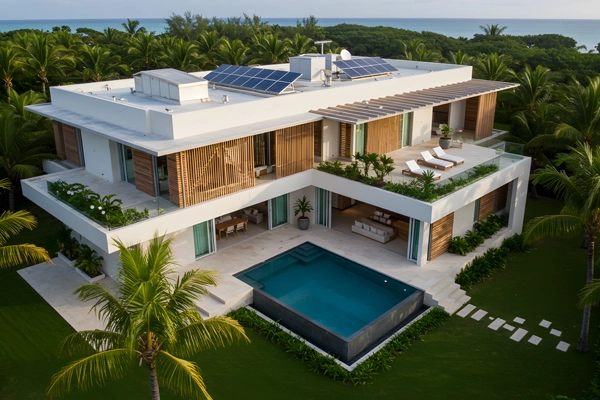The pursuit of a more sustainable lifestyle has been gaining momentum in North America, where environmental concerns and energy efficiency are top priorities.
Creating a sustainable home is not just about adopting eco-friendly practices; it’s also about integrating innovative solutions into interior design and decor, ensuring a space that is functional, comfortable, and environmentally responsible.
In this article, we explore strategies to make a home more sustainable, from choosing materials to the impact of self-care within a balanced living environment.
What Defines a Sustainable Home?
A sustainable home goes beyond reducing energy consumption—it aims to minimize environmental impact, improve resource efficiency, and enhance the residents’ quality of life. The main pillars include:
Energy efficiency: Reducing electricity usage and incorporating renewable energy sources.
Eco-friendly materials: Choosing recycled and sustainable materials for construction and decor.
Smart water management: Strategies for reuse and conservation.
Healthy indoor environment: Decisions that promote well-being and comfort in everyday life.
How to Save and Reduce Impact?
Renewable Energy Sources
. Solar panels are an excellent alternative for sustainable homes, could reduce reliance on the grid and lower the carbon footprint.
. Residential Wind Energy, in regions who have strong winds and huge open areas, turbines can supplement energy supply.
. Storage Batteries, in small spaces, could keep energy available even when the sun isn’t shining.
Thermal Insulation and Smart Climate Control
Maintaining balanced indoor temperatures is key to reducing heating and cooling costs.
Double-glazed windows and efficient frames: Reduce heat exchange, preventing energy loss.
Sustainable insulation materials: Cork, rock wool, and recycled cellulose are eco-friendly options.
Cross-ventilation: Ensures better airflow without the constant use of air conditioning.
Efficient Lighting
Choose LED bulbs, which consume less energy and last longer.
Automate lighting with sensors and smart systems.
Maximize natural light by strategically positioning windows.
Using Sustainable Materials in Construction and Decor
The choice of materials directly affects a home’s sustainability. Some eco-friendly options include:
Recycled and Renewable Materials
FSC-certified wood: Ensures responsible forest management.
Eco-friendly concrete: Produces less carbon emissions during manufacturing.
Reclaimed bricks and tiles: Reduce the need for new raw materials.
Sustainable Furniture
Choose recyclable and second-hand furniture to minimize environmental impact.
Opt for reforested wood and natural fibers.
Prioritize durability over disposable pieces.
Non-Toxic Paints and Finishes
Eco-friendly paints with water-based formulas are healthier for residents.
Natural sealants prevent the emission of volatile organic compounds (VOCs).
Organic fabrics for curtains and upholstery improve indoor air quality.
Sustainable Water Management
Saving water is essential for a sustainable home. Some efficient strategies include:
Reuse Systems and Rainwater Harvesting
Install rainwater collection tanks for reuse.
Use natural filters for purification and recycling.
Efficient Bathrooms and Faucets
Dual-flush toilets reduce water consumption.
Automatic faucets and aerators prevent waste.
Sustainable Gardens
Opt for xeriscaping, which uses drought-resistant plants.
Implement drip irrigation systems for efficient water use.
Sustainable and Functional Indoor Spaces
Biophilic Design
Integrating natural elements into the home enhances well-being.
Air-purifying plants improve indoor air quality.
Natural materials in decor create an organic and welcoming ambiance.
Outdoor-integrated areas encourage direct contact with nature.
Multifunctional Furniture
Modular furniture reduces unnecessary purchases.
Convertible pieces adapt over time, minimizing waste.
Self-Care Spaces
Create relaxation areas such as meditation and reading nooks.
Dedicate a space for wellness rituals, including aromatherapy.
Maintain an organized environment to foster visual and mental balance.
How to Transform Daily Habits into Sustainable Practices?
Beyond the home’s structure, sustainability also depends on the residents’ habits. Some actions include:
Reducing plastic use by choosing sustainable packaging.
Conscious energy and water consumption to prevent waste.
Sustainable food choices, such as urban gardening and local shopping.
Household composting to minimize organic waste.
Conclusion
Creating a sustainable home in North America requires planning, conscious decisions, and adapting to the best available ecological practices. From energy efficiency to selecting sustainable materials, every detail contributes to an eco-friendly and healthy home.
By integrating responsible solutions, a home becomes not only functional but also a space for well-being and self-care, balancing technology, nature, and quality of life.
For more articles on sustainability, see also: Ocaszen.com

